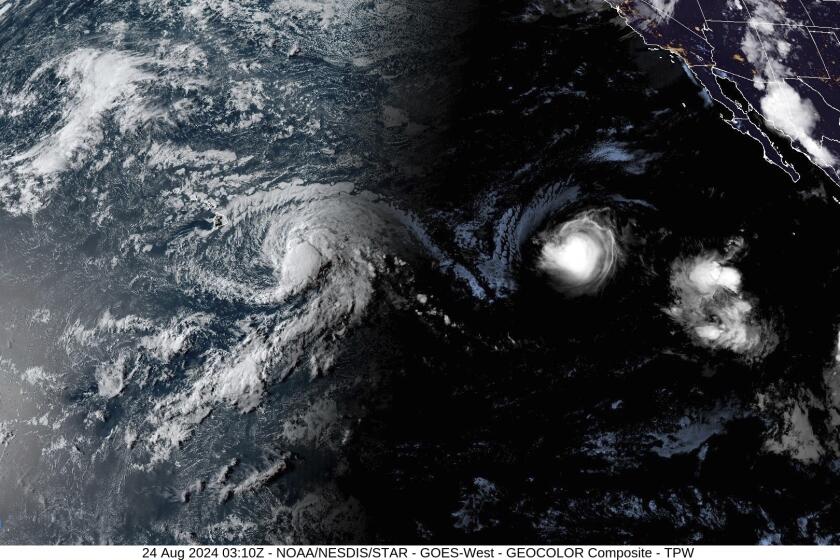Preserving Biodiversity Is Protecting Life on Earth : Environment: Why care about red squirrels, tundra, blue beetles or little bluestem grasses? Three reasons, which boil down to self-interest.
The ozone hole and the greenhouse effect have entered our public vocabulary, but we have no catchy label for the third great environmental problem of the late-20th Century. It’s even more diffuse than depletion of the ozone layer or global warming, harder to grasp and summarize. The experts call it “the loss of biodiversity.”
Biodiversity obviously has something to do with pandas, tigers and tropical forests. But preserving biodiversity is a much bigger job than protecting rainforests or charismatic megafauna. It’s the job of protecting all life--microscopic creepy-crawlies as well as elephants and condors--and all life’s habitats--tundra, prairie and swamp as well as forests.
Why care about red squirrels, for instance?
“Do we have to save every subspecies?” asked the U.S. Interior secretary, Manuel Lujan Jr., on Thursday. He called for changes in the Endangered Species Act, because it is blocking construction of a $200-million telescope on Mt. Graham in Arizona, the habitat for about 180 endangered red squirrels.
Why care about tundra, swamp, blue beetles or little bluestem grasses? Ecologists give three reasons, which boil down to simple self-interest on three levels of escalating importance.
Biodiversity has both immediate and potential economic value. This is the argument most commonly put forward to defend biodiversity, because it’s the one our culture is most ready to hear. It cites the importance of the industries most directly dependent upon nature--fisheries, forestry, tourism, recreation and the harvesting of wild foods, medicines, dyes, rubber and chemicals.
Some ecologists are so tired of this line of reasoning that they refer wearily to the “Madagascar periwinkle argument.” That obscure plant yields the drugs vincristine and vinblastine, which have revolutionized the treatment of leukemia. About a third of all modern medicines have been derived from molds and plants. The potential for future discoveries is astounding. The total number of species of life is somewhere between 10 million and 30 million, only 1.7 million of which we have named, only a fraction of which we have tested for usefulness.
The economic value of biodiversity is very real, but ecologists hate the argument because it is both arrogant and trivial. It assumes that the Earth’s millions of species are here to serve the economic purposes of just one species. And even if you buy that idea, it misses the larger and more valuable ways that nature serves us, even if we never name or harvest its millions of species.
Biodiversity performs environmental services beyond price. How would you like the job of pollinating all trillion or so apple blossoms in New York state some sunny afternoon in late May? It’s conceivable, maybe, that you could invent a machine to do it, but inconceivable that the machine could work as elegantly and cheaply as the honeybee, much less make honey on the side.
Suppose you were assigned to turn every bit of dead organic matter, from fallen leaves to urban garbage to road kills, into nutrients that feed new life. Even if you knew how, what would it cost? A host of bacteria, molds, mites and worms do it for free. If they ever stopped, all life would stop. We would not last long if green plants stopped turning our exhaled carbon dioxide back into oxygen. Plants would not last long if a few genera of soil bacteria stopped turning nitrogen from the air into nitrate fertilizer.
Human reckoning cannot put a value on the services performed by the ecosystems of earth. In addition to pollination and nutrient recycling, these services include the cleansing of air and water, flood control, drought prevention, pest control, temperature regulation and maintenance of the world’s most valuable library--the genes of all living organisms.
Biodiversity contains the accumulated wisdom of nature and the key to its future. If you ever wanted to destroy a society so thoroughly that there would be no hope of its resuscitation, you would burn its libraries and kill its intellectuals. You would destroy its knowledge. Nature’s knowledge is contained in the DNA within living cells. The variety of that genetic information is the driving engine of evolution, the immune system for life, the source of adaptability--not just the variety of species but also the variety of individuals within each species.
Individuals are never quite alike. Each is genetically unique mostly in subterranean ways that will only appear in future generations. We recognize that is true of human beings. Plant and animal breeders recognize it in dogs, cattle, wheat, roses, apples. The only reason they can bring forth bigger fruits or sweeter smells or disease resistance is that those traits are already present in the genes carried by some individuals.
The amount of information in a single cell is hard to comprehend. A simple one-celled bacterium can carry genes for 1,000 traits, a flowering plant for 400,000. Biologist E. O. Wilson says the information in the genes of an ordinary house mouse, if translated into printed letters, would fill all the 15 editions of the Encyclopedia Britannica that have been published since 1768. And each house mouse is slightly different from all the others.
The wealth of genetic information has been selected over billions of years to fit the ever-changing necessities of the planet. As Earth’s atmosphere filled with oxygen, as land masses drifted apart, as humans invented agriculture and altered the land, there were lurking within individuals pieces of genetic code that allowed them to defend against or take advantage of the changes. These individuals were more fit for the new environment. They bred more successfully. The population began to take on their characteristics. New species came into being.
Biodiversity is the accumulation of all life’s past adaptations, and it is the basis for all future adaptations (even those mediated by human gene-splicers). That’s why ecologists value biodiversity as one of the Earth’s great resources, as great as oil deposits or topsoils or fresh water. It’s why they take seriously the loss of even the most insignificant of species; why they defend not only the preservation of species but the preservation of populations within species, and why they regard the current rate of human-induced extinctions as an unparalleled catastrophe.
We don’t know how many species we are eliminating, because we don’t know how many species there are. It’s a fair guess that at the rate we’re destroying habitat, especially but not exclusively in the tropics, we’re pushing to extinction about one species every hour. That doesn’t count the species whose populations are being reduced so greatly that diversity within the population is essentially gone. Earth has not seen a spasm of extinctions like this for 65 million years.
Biologists estimate that human beings usurp, directly or indirectly, about 40% of each year’s total biological production (and our population is on its way to another doubling in 40 years). There is hardly a place on Earth where people do not log, pave, spray, drain, flood, graze, fish, plow, burn, drill, spill or dump. There is no life zone, with the possible exception of the deep ocean, that we are not degrading. In poor countries biodiversity is being nickel-and-dimed to death; in rich countries it is being billion-dollared to death.
Besides “loss of diversity,” biologists have another name for this problem--”biotic impoverishment.” What is impoverished is not just biodiversity, it is also the human economy and human spirit. Ecologist Paul Ehrlich describes biotic impoverishment this way: “Unless current trends are reversed, Americans will gradually be living in a nation that has fewer warblers and ducks and more starlings and herring gulls, fewer native wildflowers and more noxious weeds, fewer swallowtail butterflies and more cockroaches, smaller herds of elk and bigger herds of rats, less edible seafood, less productive croplands, less dependable supplies of pure freshwater, more desert wastes and dust storms, more frequent floods and more uncomfortable weather.”
Biodiversity can’t be maintained by protecting a few species in a zoo, or by preserving greenbelts or national parks. To function properly nature needs more room than that. It can maintain itself, however, without human expense, without zookeepers, park rangers, foresters or gene banks. All it needs is to be left alone.
To provide their priceless pollination service, the honeybees ask only that we stop saturating the landscape with poisons, stop paving the meadows where bee-food grows and leave them enough honey to get through the winter.
To maintain our planet, our lives and our future potential, the other species have similar requests, all of which add up to: Control yourselves. Control your numbers. Control your greed. See yourselves as what you are, part of an interdependent biological community--the most intelligent part, though you don’t often act that way.
So act that way, either out of a moral respect for something magnificent that you did not create and do not understand, or out of a practical interest in your own survival.
More to Read
Sign up for Essential California
The most important California stories and recommendations in your inbox every morning.
You may occasionally receive promotional content from the Los Angeles Times.






